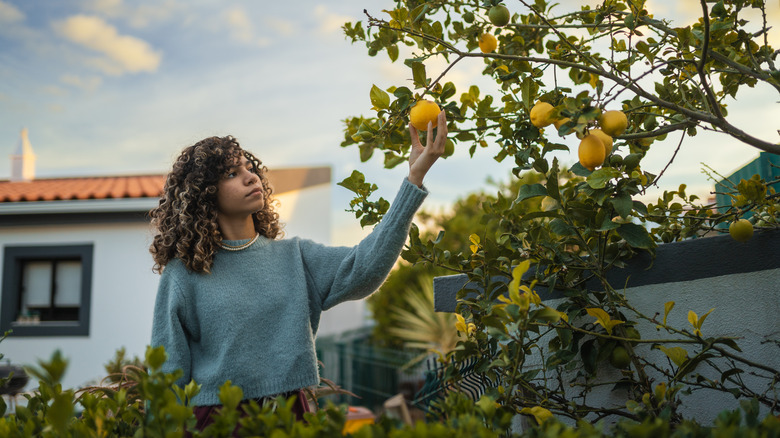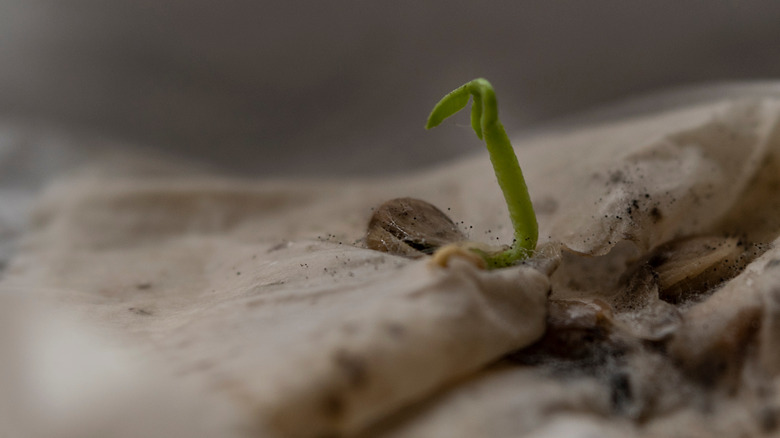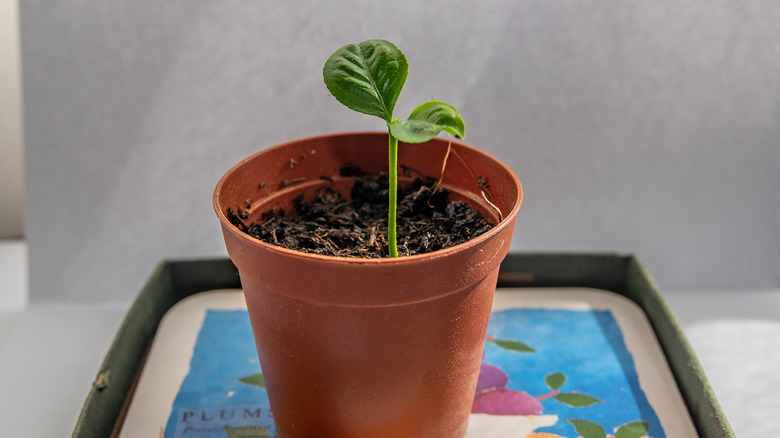The Paper Towel Hack That Makes It Easy To Germinate Lemon Seeds
A common experiment taught in plenty of science classes across the U.S., it's likely that you have germinated a seed or two on a damp paper towel. Maybe you were being taught how an avocado pit grows roots or how to test seeds for viability, but by now, you've likely forgotten all about this simple trick — so let's revisit it. Though the science of using damp paper towels to sprout seeds is limited, anecdotal evidence suggests that most large seeds, including those from lemons, are well-suited to germinating this way. Just pick a ripe lemon from your grocery store — or your neighbor's tree with permission — cut it open carefully to avoid damaging the seeds, and enjoy some ice-cold water with fresh lemon slices while you get to work.
After you've harvested at least one seed from your lemon, it's possible that you could simply rinse it, plant it in a container with potting soil, and forget about it for the next few weeks — however, your odds for successful germination are not as good. To use this paper towel hack and reap more satisfying long-term results, a few things are essential to prepare for the experiment and execute it perfectly.
How to sprout lemon seeds the easy way
The first step you should take after collecting your lemon seed is to peel off its seed coat and/or soak it in water for an hour, overnight, or even 24 hours. Soaking softens the seed's outer shell and makes it easier to remove the coat, speeding up the germination process. Once your naked seed is ready to go, take a couple of paper towels and wet them. Your lemon seed should never become dried out, so moisten the towels and lightly wring them before adding your seed — so they aren't soaked or dripping either. Then, lay out the damp towels, place your seed in the center, and fold the sheets over it multiple times until they fit into a plastic sandwich bag. Finally, store the baggie with the seed in a dark place where it won't be disturbed.
After two to three weeks, find your bag and admire the sprouted seedling. You should see roots sprouting from one end and a greenish-white stem (possibly with two small leaves) sprouting from the other. Don't fret if you notice mold on the paper towel or seedling when you take it out; this is normal as the conditions inside the bag are conducive to growth, hence your new seedling. While sprouting lemon seeds in damp paper towels is fairly fool-proof when you follow the correct steps, growing lemon trees from seed only becomes more complicated once the seedling is out of the bag.
What to know about planting lemon seedlings
Pot your lemon seedling root-side-down in a moist medium immediately after removing it from the paper towel. The small plant will not last long when exposed to dry conditions. To do this, you can fill a small container with potting soil, dig a shallow hole, and pack the roots into their new home. Right after, you'll also want to create a humidity dome by covering the seedling with the top of a plastic bottle, plastic wrap, or another transparent cloche. You may also opt to continue to grow it in water, but lemon trees can't survive this way indefinitely — so you should pot it up eventually. Allow the lemon seedling to mature for about a month — after this, or once your plant produces a few healthy leaf sets — transplant it into a larger pot or your garden.
Some people think they can harvest large, juicy lemons in just a few years after germinating their seeds. However, while these trees will produce fruit eventually, they can't do so until they mature, which typically takes 10 to 15 years. On top of this, citrus trees from seed don't grow true to type, meaning their fruit's quality and yield will fluctuate, and the trees are unlikely to be as prolific as their female parent. Remember, this makes caring for your seed-grown lemon tree a little more complicated, and in the future, it could be why that lemon tree is struggling in your garden.


